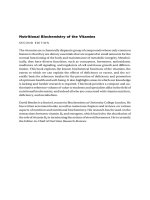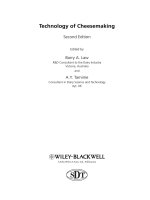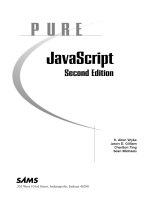Technology of Cheesemaking Second Edition pot
Bạn đang xem bản rút gọn của tài liệu. Xem và tải ngay bản đầy đủ của tài liệu tại đây (15.42 MB, 515 trang )
P1: SFK/UKS P2: SFK/UKS QC: SFK/UKS T1: SFK Color: 1C
fm BLBK264-Law April 15, 2010 13:41 Trim: 244mm X 172mm
Technology of Cheesemaking
Second Edition
Edited by
Barry A. Law
R&D Consultant to the Dairy Industry
Victoria, Australia
and
A.Y. Tamime
Consultant in Dairy Science and Technology
Ayr, UK
A John Wiley & Sons, Ltd., Publication
iii
P1: SFK/UKS P2: SFK/UKS QC: SFK/UKS T1: SFK Color: 1C
fm BLBK264-Law April 15, 2010 13:41 Trim: 244mm X 172mm
iii
P1: SFK/UKS P2: SFK/UKS QC: SFK/UKS T1: SFK Color: 1C
fm BLBK264-Law April 15, 2010 13:41 Trim: 244mm X 172mm
Technology of Cheesemaking
Second Edition
i
P1: SFK/UKS P2: SFK/UKS QC: SFK/UKS T1: SFK Color: 1C
fm BLBK264-Law April 15, 2010 13:41 Trim: 244mm X 172mm
The Society of Dairy Technology (SDT) has joined with Wiley-Blackwell to produce a series
of technical dairy-related handbooks providing an invaluable resource for all those involved
in the dairy industry, from practitioners to technologists, working in both traditional and
modern large-scale dairy operations. For information regarding the SDT, please contact
Maurice Walton, Executive Director, Society of Dairy Technology, P. O. Box 12, Appleby in
Westmorland, CA16 6YJ, UK. email:
Other volumes in the Society of Dairy Technology book series:
Probiotic Dairy Products (ISBN 978 1 4051 2124 8)
Fermented Milks (ISBN 978 0 6320 6458 8)
Brined Cheeses (ISBN 978 1 4051 2460 7)
Structure of Dairy Products (ISBN 978 1 4051 2975 6)
Cleaning-in-Place (ISBN 978 1 4051 5503 8)
Milk Processing and Quality Management (ISBN 978 1 4051 4530 5)
Dairy Fats (ISBN 978 1 4051 5090 3)
Dairy Powders and Concentrated Products (978 1 4051 5764 3)
ii
P1: SFK/UKS P2: SFK/UKS QC: SFK/UKS T1: SFK Color: 1C
fm BLBK264-Law April 15, 2010 13:41 Trim: 244mm X 172mm
Technology of Cheesemaking
Second Edition
Edited by
Barry A. Law
R&D Consultant to the Dairy Industry
Victoria, Australia
and
A.Y. Tamime
Consultant in Dairy Science and Technology
Ayr, UK
A John Wiley & Sons, Ltd., Publication
iii
P1: SFK/UKS P2: SFK/UKS QC: SFK/UKS T1: SFK Color: 1C
fm BLBK264-Law April 15, 2010 13:41 Trim: 244mm X 172mm
This edition second published 2010
First edition published 1999 Sheffield Academic Press
C
2010 Blackwell Publishing Ltd
Blackwell Publishing was acquired by John Wiley & Sons in February 2007. Blackwell’s publishing programme
has been merged with Wiley’s global Scientific, Technical, and Medical business to form Wiley-Blackwell.
Registered office
John Wiley & Sons Ltd, The Atrium, Southern Gate, Chichester, West Sussex, PO19 8SQ, United Kingdom
Editorial offices
9600 Garsington Road, Oxford, OX4 2DQ, United Kingdom
2121 State Avenue, Ames, Iowa 50014-8300, USA
For detailsof ourglobal editorial offices, forcustomer services andfor informationabout how toapply forpermission
to reuse
the copyright material in this book please see our website at www.wiley.com/wiley-blackwell.
The right of the author to be identified as the author of this work has been asserted in accordance with the UK
Copyright, Designs and Patents Act 1988.
All rights reserved. No part of this publication may be reproduced, stored in a retrieval system, or transmitted, in
any form or by any means, electronic, mechanical, photocopying, recording or otherwise, except as permitted by
the UK Copyright, Designs and Patents Act 1988, without the prior permission of the publisher.
Wiley also publishes its books in a variety of electronic formats. Some content that appears in print may not be
available in electronic books.
Designations used by companies to distinguish their products are often claimed as trademarks. All brand names
and product names used in this book are trade names, service marks, trademarks or registered trademarks of
their respective owners. The publisher is not associated with any product or vendor mentioned in this book. This
publication is designed to provide accurate and authoritative information in regard to the subject matter covered.
It is sold on the understanding that the publisher is not engaged in rendering professional services. If professional
advice or other expert assistance is required, the services of a competent professional should be sought.
Library of Congress Cataloging-in-Publication Data
Technology of cheesemaking / edited by Barry A. Law, A.Y. Tamime. – 2nd ed.
p. cm.
Includes bibliographical references and index.
ISBN 978-1-4051-8298-0 (hardback : alk. paper)
1. Cheesemaking. I. Law, Barry A. II. Tamime, A. Y.
SF271.T36 2010
637
.3–dc22
2009048133
A catalogue record for this book is available from the British Library.
Set in 10/12.5pt Times by Aptara
R
Inc., New Delhi, India
Printed in Singapore
1 2010
iv
P1: SFK/UKS P2: SFK/UKS QC: SFK/UKS T1: SFK Color: 1C
fm BLBK264-Law April 15, 2010 13:41 Trim: 244mm X 172mm
Contents
Preface to the Technical Series xvi
Preface to the Second Edition xvii
Preface to the First Edition xix
Contributors xxi
1 The Quality of Milk for Cheese Manufacture 1
T.P. Guinee and B. O’Brien
1.1 Introduction 1
1.2 Overview of milk composition 2
1.2.1 Casein 3
1.2.2 Whey protein 6
1.2.3 Minerals 7
1.2.4 Milk lipids 8
1.3 Principles of cheese manufacture 9
1.3.1 Rennet-induced gelation 10
1.3.2 Acid-induced gelation 13
1.4 Quality definition of milk 15
1.4.1 Safety/public health (pathogens including Mycobacterium
tuberculosis, Brucella spp., toxic residues, and contaminants) 16
1.4.2 Composition (protein, casein, fat, total solids, lactose, and
mineral) 18
1.4.3 Microbiology (total bacterial count) 22
1.4.4 Sensory (appearance, colour, smell, and taste) 23
1.4.5 Authenticity (non-adulteration with residues or other milks/milk
fractions) 23
1.5 Factors affecting the quality of milk for cheese manufacture 24
1.5.1 Milk composition 24
1.5.2 Microbial activity of milk 31
1.5.3 Somatic cell count 34
1.5.4 Enzymatic activity of milk 36
1.5.5 Chemical residues 43
1.6 Strategy for quality milk production 45
1.7 Conclusions 47
References 50
v
P1: SFK/UKS P2: SFK/UKS QC: SFK/UKS T1: SFK Color: 1C
fm BLBK264-Law April 15, 2010 13:41 Trim: 244mm X 172mm
vi Contents
2 The Origins, Development and Basic Operations of Cheesemaking
Technology 68
M. Johnson and B.A. Law
2.1 Introduction 68
2.2 The world market for cheese 68
2.3 The fundamentals of cheese technology 69
2.4 Basic cheese manufacture 70
2.5 The stages of cheesemaking 77
2.5.1 Standardisation of milk 77
2.5.2 Heat treatment of milk 78
2.5.3 Addition of the starter culture 78
2.5.4 Coagulation and cutting 80
2.5.5 Stirring, heating and syneresis (moisture control) 81
2.5.6 Whey removal, hooping and salting 83
2.5.7 Brining and/or dry surface salting 85
2.5.8 Pressing 86
2.6 Cheese ripening/maturation 87
2.6.1 Diversity arising from composition 87
2.6.2 Diversity arising from the starter cultures and the adventitious
microflora in cheese 87
2.7 Reduced-fat versions of traditional cheeses 88
2.7.1 Background 88
2.7.2 Manufacture of reduced-fat cheese 89
2.8 Whey technology for cheesemakers 90
2.8.1 The composition of cheese whey 91
2.8.2 Membrane filtration technology 91
2.8.3 Whey pre-treatment 93
2.8.4 Production of WPC 94
2.8.5 Lactose recovery 95
2.9 The role of research and development in the future of cheese technology 95
2.10 Acknowledgements 96
References 96
3 The Production, Action and Application of Rennet and Coagulants 98
M. Harboe, M.L. Broe and K.B. Qvist
3.1 Historical background and nomenclature 98
3.2 Types of rennet and coagulants 99
3.2.1 Animal rennet and coagulants 99
3.2.2 Microbial coagulants 100
3.2.3 Fermentation-produced chymosin 100
3.2.4 Vegetable coagulants 101
3.3 Molecular aspects of the enzymes in rennet and coagulants 101
3.3.1 Introduction 101
3.3.2 Specific molecular aspects 102
P1: SFK/UKS P2: SFK/UKS QC: SFK/UKS T1: SFK Color: 1C
fm BLBK264-Law April 15, 2010 13:41 Trim: 244mm X 172mm
Contents vii
3.4 Technology of enzymes production 103
3.4.1 General background 103
3.4.2 Production of enzymes 103
3.4.3 Formulation, standardisation and quality control 106
3.5 Analysis of coagulants 107
3.6 Legislation and approvals 110
3.7 Physical chemistry and kinetics of enzymatic coagulation
of milk 111
3.7.1 Stability and destabilisation of the casein micelles 111
3.7.2 Kinetics of enzymatic coagulation of milk 112
3.8 Application of rennet and coagulants 115
3.8.1 Trends in use 115
3.8.2 Handling and use of rennet and coagulants 116
3.8.3 Milk quality, treatment and additives 116
3.8.4 Controlling the curd firmness at cutting 119
3.8.5 Performance of different rennet and coagulants available
in the market 119
3.8.6 Coagulants and cheese ripening 123
3.8.7 Choice of coagulant 124
3.9 Conclusions 125
References 125
4 The Formation of Cheese Curd 130
T. Janhøj and K.B. Qvist
4.1 Introduction 130
4.2 Chemistry and physics of curd formation 130
4.2.1 Some factors affecting aggregation 130
4.2.2 Formation of a gel 133
4.2.3 Rheological properties of rennet gels 135
4.2.4 Syneresis 138
4.3 Effect of milk composition on curd formation 140
4.3.1 Variations in main components 140
4.3.2 Casein micelle size 141
4.3.3 Genetic polymorphism of milk proteins 141
4.3.4 Lactational variation and somatic cell count 142
4.4 Effects of milk pre-treatment on curd formation 143
4.4.1 Cooling 143
4.4.2 High heat treatment 144
4.4.3 Restoring the rennetability of high heat treated milk 145
4.4.4 pH adjustment by carbon dioxide injection 146
4.4.5 Homogenisation 147
4.4.6 Phopholipase addition 147
4.4.7 Microfiltration and microfiltration combined with heat
treatment 148
P1: SFK/UKS P2: SFK/UKS QC: SFK/UKS T1: SFK Color: 1C
fm BLBK264-Law April 15, 2010 13:41 Trim: 244mm X 172mm
viii Contents
4.5 Factors controlling curd formation in the vat 148
4.5.1 Rennet concentration 149
4.5.2 pH 149
4.5.3 Temperature 150
4.5.4 Cutting time 151
4.5.5 Washing of the curd 151
4.6 On-line measurement of curd firmness and syneresis 152
4.6.1 On-line measurement of curd setting 152
4.6.2 Modelling and controlling gelation and cutting time 152
4.6.3 On-line measurement of syneresis 153
4.7 Cheese with reduced-fat content 154
References 156
5 The Production, Application and Action of Lactic Cheese Starter Cultures 166
E. Høier, T. Janzen, F. Rattray, K. Sørensen, M.W. Børsting, E. Brockmann
and E. Johansen
5.1 Introduction 166
5.2 Historical background 166
5.3 Production of starter cultures 167
5.4 Range of LAB used as starter cultures 169
5.4.1 Traditional starter cultures 169
5.4.2 Probiotic starter cultures 170
5.5 Taxonomy of LAB 172
5.5.1 Identification 172
5.5.2 Species important in cheese making 173
5.6 The types of lactic cultures 174
5.6.1 Development of mesophilic cultures 174
5.6.2 Use of DVS cultures 175
5.6.3 Selection of culture strains 177
5.7 Modern approaches to the development of new starter cultures 177
5.7.1 Genomics and traditional bacterial genetics 177
5.7.2 Food-grade GMOs for the dairy industry 178
5.7.3 Use of automated laboratory methods to develop new
starter cultures 179
5.8 Biochemistry of acidification by LAB 180
5.8.1 Introduction 180
5.8.2 Sugar metabolism 180
5.9 Proteolysis by LAB 181
5.9.1 Proteases 181
5.9.2 Peptidases of LAB 182
5.9.3 Amino acid catabolism by LAB 183
5.10 Bacteriophage of LAB 183
5.10.1 Phage control during culture preparation 184
P1: SFK/UKS P2: SFK/UKS QC: SFK/UKS T1: SFK Color: 1C
fm BLBK264-Law April 15, 2010 13:41 Trim: 244mm X 172mm
Contents ix
5.10.2 Phage control in the dairy 184
5.10.3 Phage monitoring 185
5.11 Development of phage-resistant starters 186
5.11.1 Isolation of spontaneous phage-resistant mutants 186
5.11.2 Conjugal transfer of phage resistance plasmids 186
5.11.3 Inhibition of phage adsorption 187
5.11.4 Prevention of phage DNA injection 187
5.11.5 Restriction and modification systems 187
5.11.6 Abortive infection 187
5.11.7 Additional routes to bacteriophage resistance 187
5.12 Future perspectives in starter culture development 188
References 189
6 Secondary Cheese Starter Cultures 193
W. Bockelmann
6.1 Introduction 193
6.2 Surface-ripened cheeses 198
6.2.1 Examples of some popular varieties 198
6.2.2 Control of surface ripening 199
6.3 Classification of secondary starter cultures 200
6.3.1 Moulds and yeasts 200
6.3.2 Staphylococci 201
6.3.3 Coryneforms 202
6.4 Commercially available secondary cheese starter cultures 203
6.4.1 Moulds 203
6.4.2 Yeasts 204
6.4.3 Brevibacteria 205
6.4.4 Staphylococci 205
6.4.5 Coryneforms 205
6.4.6 Mixed starter cultures 206
6.5 Surface ripening 206
6.5.1 Ripening strategies 206
6.5.2 Yeasts and moulds 207
6.5.3 Staphylococci 209
6.5.4 Smear bacteria (coryneforms) 209
6.5.5 Food safety 211
6.5.6 Old–young smearing 211
6.5.7 L. monocytogenes 213
6.5.8 Mould spoilage 213
6.5.9 Anti-listeria starter cultures 214
6.6 Development of defined surface starter cultures 215
6.6.1 Surface starter cultures for semi-soft cheeses 216
6.6.2 Surface starter cultures for smeared soft cheeses 217
6.6.3 Starter cultures for acid curd cheeses (yellow type) 218
P1: SFK/UKS P2: SFK/UKS QC: SFK/UKS T1: SFK Color: 1C
fm BLBK264-Law April 15, 2010 13:41 Trim: 244mm X 172mm
x Contents
6.6.4 Colour development 220
6.6.5 Application of defined starter cultures 220
6.7 Proteolysis and lipolysis 221
6.8 Aroma 222
6.9 Conclusions 224
References 224
7 Cheese-Ripening and Cheese Flavour Technology 231
B.A. Law
7.1 Introduction 231
7.2 The breakdown of milk proteins to flavour compounds in cheese 231
7.2.1 Proteinase and peptidase enzymes (proteolytic systems) 231
7.2.2 Amino acid catabolism 235
7.3 Breakdown of milk lipids in cheese 237
7.4 Lactose and citrate metabolism in cheese 238
7.5 The commercial drive for cheese-ripening and flavour technology 239
7.6 Commercial opportunities created by cheese-ripening and flavour
technologies 240
7.7 Methods for the controlled and accelerated ripening of cheese 241
7.7.1 Elevated storage temperatures 241
7.7.2 Ultra-high-pressure technology 244
7.7.3 Enzyme additions 244
7.7.4 Attenuated starter cultures 246
7.7.5 Non-starter adjunct cultures 248
7.7.6 Genetically modified LAB 249
7.7.7 Rules and regulations for GMOs in foods 252
7.8 EMCs and cheese flavour products 253
7.9 Acknowledgements 255
References 255
8 Control and Prediction of Quality Characteristics in the Manufacture and
Ripening of Cheese 260
T.P. Guinee and D.J. O’Callaghan
8.1 Introduction 260
8.2 Principles of cheese manufacture 262
8.3 Cheese quality characteristics 264
8.3.1 Definition of cheese quality 264
8.3.2 Assessment of cheese quality 264
8.3.3 Sensory tests 266
8.3.4 Rheology and texture of cheese 267
8.3.5 Colorimetry 268
8.3.6 Image analysis 268
8.4 Cheese quality: influence of chemical composition of milk 269
P1: SFK/UKS P2: SFK/UKS QC: SFK/UKS T1: SFK Color: 1C
fm BLBK264-Law April 15, 2010 13:41 Trim: 244mm X 172mm
Contents xi
8.5 Cheese quality: effect of milk pre-treatments and manufacturing
operations 271
8.5.1 Cold storage of milk prior to pasteurisation at the cheese factory 271
8.5.2 Thermisation 273
8.5.3 Milk pasteurisation and incorporation of in situ denatured whey
proteins 273
8.5.4 Bactofugation 279
8.5.5 Clarification 280
8.5.6 Standardisation of protein-to-fat ratio 280
8.5.7 Homogenisation 286
8.5.8 Addition of calcium chloride 289
8.5.9 Milk gelation 290
8.5.10 Curd-cutting programmes 291
8.5.11 Stirring and cooking 294
8.5.12 Curd washing: standardisation of lactose level in the moisture
phase of the curd 295
8.5.13 Whey drainage and remaining operations 298
8.6 Cheese quality: effect of cheese composition 299
8.7 Cheese quality: effect of ripening 301
8.7.1 Overview of the ripening process 301
8.7.2 Factors affecting ripening 303
8.8 Quality assurance in cheese manufacture 304
8.8.1 Background 304
8.8.2 Key concepts in quality assurance 305
8.8.3 Control and prediction of quality characteristics of curd and
cheese 310
8.8.4 Robots in cheese manufacturing 313
8.9 Conclusions 313
References 314
9 Technology, Biochemistry and Functionality of Pasta Filata/Pizza Cheese 330
P.S. Kindstedt, A.J. Hillier and J.J. Mayes
9.1 Introduction 330
9.2 Measuring functional properties of pizza cheese 330
9.2.1 Background 330
9.2.2 Measurement of functionality 331
9.3 Manufacture of pizza cheese 332
9.3.1 Treatment of milk 332
9.3.2 Starter culture 334
9.3.3 Coagulant 337
9.3.4 Cooking and cheddaring 338
9.3.5 Stretching and moulding 339
9.3.6 Brining/salting 342
P1: SFK/UKS P2: SFK/UKS QC: SFK/UKS T1: SFK Color: 1C
fm BLBK264-Law April 15, 2010 13:41 Trim: 244mm X 172mm
xii Contents
9.3.7 Process control in pizza cheese manufacture 344
9.3.8 Factors affecting cheese yield 345
9.4 Microbiological, proteolytic and physicochemical properties 345
9.4.1 Microbiological properties 345
9.4.2 Proteolytic properties 347
9.4.3 Physicochemical properties 347
9.4.4 Functionality changes during storage 349
9.5 Non-traditional methods of manufacture 349
9.5.1 Direct acidification 349
9.5.2 Cheese blends 350
9.5.3 Low-fat pizza cheese 350
9.5.4 Imitation (analogue) pizza cheese 351
9.5.5 Processed pizza cheese 352
References 352
10 Eye Formation and Swiss-Type Cheeses 360
A. Thierry, F. Berthier, V. Gagnaire, J.R. Kerjean, C. Lopez and Y. No
¨
el
10.1 Introduction 360
10.1.1 Which kinds of cheese? 360
10.1.2 Manufacture and chemical composition 361
10.1.3 Scope of the present chapter 361
10.2 Open texture and eye formation 363
10.2.1 Gas production – a sign of quality 363
10.2.2 Eye formation 365
10.2.3 Cheese cohesion 366
10.3 Gas formation through propionic fermentation 366
10.3.1 Main sources of gas in Swiss-type cheeses 366
10.3.2 Taxonomy, ecology and presence of PAB in cheese 367
10.3.3 Metabolism of PAB 368
10.3.4 Influence of LAB on propionibacteria 370
10.3.5 Relationship between eye formation and flavour development 371
10.4 Cheese structure and eye formation 372
10.4.1 Mechanical properties and eye formation of cheese 372
10.4.2 Changes during ripening and eye formation 374
10.4.3 Eye formation and slit development 376
10.5 Conclusions 377
References 378
11 Microbiological Surveillance and Control in Cheese Manufacture 384
P. Neaves and A.P. Williams
11.1 Introduction 384
11.2 Milk for cheese manufacture 386
11.3 Heat treatment 389
P1: SFK/UKS P2: SFK/UKS QC: SFK/UKS T1: SFK Color: 1C
fm BLBK264-Law April 15, 2010 13:41 Trim: 244mm X 172mm
Contents xiii
11.4 Cheesemaking 391
11.5 Maturation of the curd 393
11.6 Specialist cheeses and cheese products 394
11.6.1 Cheeses made from unpasteurised milk 395
11.6.2 Grated cheese for manufacture 395
11.6.3 Cheese with additives 396
11.6.4 Processed cheeses 396
11.7 Cheese defects 397
11.8 Prevention and control 399
11.9 End-product testing and environmental monitoring 401
11.9.1 End-product testing 401
11.9.2 Environmental monitoring 404
11.10 Microbiological techniques 406
11.11 Conclusions 408
References 409
12 Packaging Materials and Equipment 413
Y. Schneider, C. Kluge, U. Wei and H. Rohm
12.1 Introduction 413
12.2 Cutting of the cheese 415
12.2.1 Characteristics and features of food cutting 415
12.2.2 Parameters affecting cutting performance 416
12.2.3 Cutting velocity 417
12.3 Applications of cutting 419
12.3.1 Partitioning and segmentation 419
12.3.2 Slicing 420
12.3.3 Dicing 420
12.3.4 Shredding 421
12.4 Packaging of cheeses 421
12.4.1 Specific requirements 421
12.4.2 Packaging materials 422
12.4.3 Packaging of hard and semi-hard cheeses 425
12.4.4 Packaging of soft cheeses 428
12.5 Packaging machines 428
12.5.1 Control of the packaging process 428
12.5.2 Machinery for cheese packaging 430
12.5.3 Miscellaneous methods of cheese packaging 436
12.6 Conclusion 437
References 438
13 The Grading and Sensory Profiling of Cheese 440
D.D. Muir
13.1 Introduction to cheese-grading systems 440
13.2 Fundamentals of sensory processing 440
P1: SFK/UKS P2: SFK/UKS QC: SFK/UKS T1: SFK Color: 1C
fm BLBK264-Law April 15, 2010 13:41 Trim: 244mm X 172mm
xiv Contents
13.2.1 The three dimensions of sensory experience 440
13.2.2 Integration versus selection of sensory information 441
13.3 Grading systems: defect versus attribute grading 442
13.3.1 The Australian grading system 442
13.3.2 The UK grading system 443
13.3.3 The US grading system 443
13.3.4 The Canadian grading system 443
13.3.5 The International Dairy Federation grading system 443
13.3.6 The New Zealand grading system 444
13.4 The direct link: cheesemaking to consumer 444
13.4.1 The link between cheesemaking, grading and the consumer 444
13.4.2 The link between grading and consumer 445
13.4.3 The cheesemaking – grading link 446
13.5 Introduction to sensory profiling of cheese 446
13.6 Sensory vocabulary 447
13.6.1 A working vocabulary for cheese 448
13.6.2 Evolution of the vocabulary 448
13.7 Sample preparation and presentation 448
13.7.1 Environment 448
13.7.2 Isolation 449
13.7.3 Rating of samples 449
13.7.4 Presentation order 449
13.8 Assessor selection 450
13.8.1 Internal versus external panels 450
13.8.2 Pre-selection procedure 450
13.8.3 Initial testing 451
13.8.4 Acclimatisation and confirmation 451
13.8.5 Monitoring assessors’ performance 452
13.9 Integrated design and analysis of data 452
13.9.1 The design, data capture and analysis of the
sensory-profiling protocol 452
13.9.2 Preliminary treatment 453
13.9.3 Sensory space maps 454
13.9.4 Principal Component Analysis 455
13.9.5 Interpretation of sensory dimensions 456
13.9.6 Generalised Procrustes Analysis (GPA) 458
13.9.7 Interpretation of sensory space maps 459
13.9.8 Multivariate prediction 459
13.9.9 Measurement of assessors’ performance 461
13.10 Sensory character of commercial cheese 467
13.10.1 Comparison of maturity declaration on cheese packaging
with sensory panel ratings 467
13.10.2 Discrimination amongst cheese types 468
13.11 Development of flavour lexicons 469
P1: SFK/UKS P2: SFK/UKS QC: SFK/UKS T1: SFK Color: 1C
fm BLBK264-Law April 15, 2010 13:41 Trim: 244mm X 172mm
Contents xv
13.12 Overview 471
13.13 Acknowledgements 472
References 472
Index 475
P1: SFK/UKS P2: SFK/UKS QC: SFK/UKS T1: SFK Color: 1C
fm BLBK264-Law April 15, 2010 13:41 Trim: 244mm X 172mm
Preface to the Technical Series
For more than 60 years, the Society of Dairy Technology (SDT) has sought to provide
education and training in the dairy field, disseminating knowledge and fostering personal de-
velopment through symposia, conferences, residential courses, publications, and its journal,
the International Journal of Dairy Technology (previously published as the Journal of the
Society of Dairy Technology).
In recent years, there have been significant advances in our understanding of milk systems,
probably the most complex natural food available to man. At the same time, improvements
in process technology have been accompanied by massive changes in the scale of many milk
processing operations, and the manufacture a wide range of dairy and other related products.
The Society has embarked on a project with Wiley-Blackwell to produce a technical
series of dairy-related books to provide an invaluable source of information for practicing
dairy scientists and technologists, covering the range from small enterprises to modern
large-scale operation. This ninth volume in the series, the second edition of Technology of
Cheesemaking under the joint editorship of Barry Law and Adnan Tamime, provides a timely
and comprehensive update on the principles and practices involved in cheese production. This
new edition also introduces chapters on milk for cheesemaking, packaging technology for
cheese and the prediction and control of the overall manufacturing process for hard cheeses.
This book provides a timely and valuable review of the progress being made in the greater
understanding of the factors contributing to cheesemaking and how this knowledge may be
applied to producing better and more consistent products.
Andrew Wilbey
Chairman of the Publications Committee, SDT
xvi
P1: SFK/UKS P2: SFK/UKS QC: SFK/UKS T1: SFK Color: 1C
fm BLBK264-Law April 15, 2010 13:41 Trim: 244mm X 172mm
Preface to the Second Edition
The first edition of Technology of Cheesemaking aimed to assess critically the pool of
scientific knowledge, which was then available to the cheesemaking industry as a tool for
process and product innovation, quality improvement and safety. I had also hoped to provide
an advanced text that would help those in higher education to understand the way that
knowledge from strategic and applied research can be fed into commercial innovation in
cheese manufacture and distribution. To this end, the second edition is intended to update
that knowledge pool in the light of further demands for new data and technologies from an
already mature industry seeking to further refine and expand its products and its production
technologies. We have covered advances in the fields of coagulants, starter cultures and
the manufacturing/maturation of a range of generic cheese varieties in order to update the
original chapters, and also introduced new chapters in fields that have advanced dramatically
over the ten years that have elapsed since the first edition.
New areas include specific coverage of milk pre-treatment science and technologies,
emphasising the special needs of cheesemakers for a consistent and safe raw material.
Emerging technologies that were confined to experimental studies ten years ago are now
applied to improve the manufacturing properties of milk for cheesemaking.
We have also introduced an appraisal of the key stages of cheese manufacture which
can be manipulated to control and maintain the consistency quality of cheese. Although
this has produced some overlap with our coverage of milk quality for cheesemaking, we
have felt justified in allowing this overlap because it emphasises the prime importance of
milk preparation practice for the quality and consistency of cheese for the end user. We
also acknowledge that many of these control techniques have been known and used by
cheesemakers for many years, but it is only more recently that the science base has delivered
a level of basic understanding of their underlying workings. This has led to refinements
and new opportunities in cheese production recipes and line technologies, which we have
included in this volume.
The first edition did not include packaging as a separate field for scientific and techno-
logical input into cheese manufacture. In recognition of the vital role of this area within the
industry, and the knowledge-based advances in packaging methods specifically applicable to
such a ‘live’ and varied product as cheese, the second edition includes a chapter dedicated to
the knowledge and application of packaging materials and equipment. This includes general
principles, through to specific challenges from cheese technology.
We would like to acknowledge the time and effort that the expert contributors have given
to make this second edition possible. Many are the original authors who helped create the
first edition, and our thanks go to them for adding to their already excellent work. We were
xvii
P1: SFK/UKS P2: SFK/UKS QC: SFK/UKS T1: SFK Color: 1C
fm BLBK264-Law April 15, 2010 13:41 Trim: 244mm X 172mm
xviii Preface to the Second Edition
also fortunate to have a number of new contributors, and we hope they will be as exciting by
the results of their efforts as we are, in that this updated volume reflects another decade of
progress in the industry and its base of science and technology.
Whilst reflecting on the satisfaction of delivering this volume, we must also pay special
tribute to our colleague, Tony Williams, who passed away while the book was in final
preparation. Tony, with his partner Paul Neaves, was an outstanding food microbiologist
and a vital member of the team which delivered great practical benefits to food quality and
safety through the astute gathering and application of basic knowledge to the sharp end of
the food industry; the interface between the manufacturer and the retailer/consumer. Tony
will be missed not only by those close to him, but also by professionals in food microbiology
worldwide.
Barry Law and Adnan Tamime
October 2009
P1: SFK/UKS P2: SFK/UKS QC: SFK/UKS T1: SFK Color: 1C
fm BLBK264-Law April 15, 2010 13:41 Trim: 244mm X 172mm
Preface to the First Edition
Cheesemaking remains an art even today, when many of the once-variable stages of the
process have been smoothed out by technology. The purpose of this book was to present the
state of the art, to show where and how technology enhances the art, and to point the
way towards further improvements in cheesemaking technology, which are achievable
through exploitation of the basic science and technology. The book is about cheesemak-
ing technology, and I hope that the reader will be able to feel the excitement of uncertainty
band the satisfaction of success-through-understanding that cheesemakers experience when
the product of their combined know-how and machinery emerges just as they say, the sellers
of the cheeses and consumer would have liked.
It is not my intention to develop a complacent view of cheesemaking – it is hard work, and
it sometimes goes wrong. However, I firmly believe that cheese technology supports one of
the most advanced food manufacturing industries in the world, having overcome most of the
problems of milk variability, microbiological control and culture failure that used to cause
so much wastage and potential hazard for consumers. In this volume, we firstly describe and
discuss cheesemaking technology from the point of view of cheesemakers. Authors explain
the process step by step, showing how the universal elements of milk-conversion technology
can be varied by process design and culture technology to yield so many wonderful and
individual varieties of cheeses. The book is unique in this respect, and it will add to existing
range of books and review articles by viewing cheese technology as the product of tradition,
pragmatic development and the application of front-line science.
Having established a detailed knowledge of cheesemaking per se, authors take the reader
on to learn about rennets and coagulants – how they are made, standardised and used,
and their concerted action (with lactic starter cultures) in forming the basis of all cheese,
the curd. Following a logical progression, the book proceeds to consider how the lactic
culture, the added moulds and non-lactics, and the eye-forming bacteria work in and on the
ripening cheese in their different ways to convert the bland curd into the familiar cheddars,
pizza cheeses, blue cheeses, camembert, Swiss-type cheeses and the aromatic smear-ripened
varieties. Pressure on cheesemakers to produce both traditional and new varieties from
increasingly uniform and controlled plant has pushed cheese technology to find new ways
of accelerating and controlling the balance of cheese ripening – topics which this volume
covers in depth.
Cheesemakers are ultimately answerable to, and dependent on, consumers for their liveli-
hoods. This book includes chapters on food safety assurance as well on cheese grading and
sensory assessment, showing how to ensure that the technology not only produces what the
cheesemaker intends to do, but what the consumer expects and wants.
xix
P1: SFK/UKS P2: SFK/UKS QC: SFK/UKS T1: SFK Color: 1C
fm BLBK264-Law April 15, 2010 13:41 Trim: 244mm X 172mm
xx Preface to the First Edition
The book is for the enlightenment and support of a wide range of potential readers, ranging
from the forever curious to cheesemakers who want to understand more clearly what they
are making every day. It will be equally valuable to product development specialists seeking
insights into the scope for innovation from the basic cheese technology, and to advanced
students of food science and technology wishing to go beyond the standard cheese textbook.
The experienced research scientist will find in these pages many examples of the working
interface between research and applications,through which to establish communications with
product development technologists. By including chapters by specialists in the technology of
coagulants, cultures and ripening systems, we have widened the value of the book to include
the interests of the dairy ingredients business.
I should like to acknowledge the contributors to this book. It is all very well to have
an idea about a new approach to the integration of cheesemaking practice, technology and
underlying science but, without the help of this group of expert and very busy people, the
idea would be unattainable. Thank you all and please remember that any shortcomings in the
quality of the book are the responsibility of me alone.
Barry A. Law
P1: SFK/UKS P2: SFK/UKS QC: SFK/UKS T1: SFK Color: 1C
fm BLBK264-Law April 15, 2010 13:41 Trim: 244mm X 172mm
Contributors
Editor
Dr. A.Y. Tamime
24 Queens Terrace
Ayr KA7 1DX
UK
Tel. +44 (0)1292 265498
Fax +44 (0)1292 265498
Mobile +44 (0)7980 278950
E-mail:
Contributors
Dr. F. Berthier
INRA
UR 342 URTAL, Technologie et Analyses
Laiti
`
eres
39801 Poligny
France
Tel.+33(0)384376313
Fax:+33(0)384373781
E-mail:
Dr. W. Bockelmann
Federal Research Centre for Nutrition and
Food (BFEL)
Location Kiel
Hermann Weigmann Straße 1
P.O. Box 6069
24121 Kiel
Germany
Tel. +49 (0)431 609 2438
Fax +49 (0)431 609 2306
E-mail:
Ms M.W. Børsting
Chr. Hansen A/S
10-12 Bøge All
´
e
DK-2970 Hørsholm
Denmark
Tel. +45 (0)45 74 85 38 (direct)
Fax +45 (0)45 74 88 16
E-mail:
Dr. E. Brockmann
Chr. Hansen A/S
10-12 Bøge All
´
e
DK-2970 Hørsholm
Denmark
Tel. +45 (0)45 74 85 16 (direct)
Fax +45 (0)45 74 89 94
E-mail:
Mr.M.L.Broe
Chr. Hansen A/S
10-12 Bøge All
´
e
DK-2970 Hørsholm
Denmark
Tel. +45 (0)45 74 85 04 (direct)
Fax +45 (0)45 74 88 16
E-mail:
Dr. V. Gagnaire
INRA
Agrocampus Rennes
UMR 1253 Science et Technologie du Lait
et de l’Oeuf
65 Rue de Saint Brieuc
35042 Rennes Cedex
France
xxi
P1: SFK/UKS P2: SFK/UKS QC: SFK/UKS T1: SFK Color: 1C
fm BLBK264-Law April 15, 2010 13:41 Trim: 244mm X 172mm
xxii Contributors
Tel. +33 (0)2 23 48 53 46
Fax +33 (0)2 23 48 53 50
E-mail:
Dr. T.P. Guinee
Moorepark Food Research Centre
Teagasc Moorepark
Fermoy
Co. Cork
Ireland
Tel. +353 (0)25 42204
Fax: +353 (0)25 42340
E-mail:
Dr. M. Harboe
Chr. Hansen A/S
10-12 Bøge All
´
e
DK-2970 Hørsholm
Denmark
Tel. +45 (0)45 74 85 25 (direct)
Fax +45(0)45748816
E-mail:
Dr. A.J. Hillier
CSIRO Food and Nutritional Sciences
Private Bag 16
Werribee
Victoria 3030
Australia
Tel. +61 (0)3 9731 3268
Fax +61 (0)3 9731 3322
E-mail:
Mr.E.Høier
Chr. Hansen A/S
10-12 Bøge All
´
e
DK-2970 Hørsholm,
Denmark
Tel. +45 (0)45 74 85 13 (direct)
Fax +45(0)45748816
E-mail:
Dr. T. Janhøj
Department of Food Science
Faculty of Life Sciences
Rolighedsvej 30
1958 Frederiksberg C
Denmark
Tel. +45 (0)3533 3192
Mobile +45 (0) 2089 3183
Fax +45 (0)3533 3190
E-mail:
Dr. T. Janzen
Chr. Hansen A/S
10-12 Bøge All
´
e
DK-2970 Hørsholm
Denmark
Tel. +45 (0)45 74 84 63 (direct)
Fax +45 (0)45 74 89 94
E-mail:
Dr. E. Johansen
Chr. Hansen A/S
10-12 Bøge All
´
e
DK-2970 Hørsholm
Denmark
Tel. +45 (0)45 74 84 64 (direct)
Fax +45 (0)45 74 89 94
E-mail:
Dr. M. Johnson
Wisconsin Centre for Dairy Research
Wisconsin University
1605 Linden Drive
Madison, WI 53562
USA
Tel. +1 (0)608 262 0275
Fax
+1 (0)608 262 1578
E-mail:
Dr. J.R. Kerjean
Actilait – P
ˆ
ole Ouest
P.O. Box 50915
35009 Rennes Cedex
France
Tel. +33 (0)2 23 48 55 88
Fax +33 (0)2 23 48 55 89
E-mail:
P1: SFK/UKS P2: SFK/UKS QC: SFK/UKS T1: SFK Color: 1C
fm BLBK264-Law April 15, 2010 13:41 Trim: 244mm X 172mm
Contributors xxiii
Dr. P.S. Kindstedt
Department of Nutrition and Food
Science
University of Vermont
253 Carrigan Wing
Burlighton
Vermont 05405-0086
USA
Tel. +1 802 656 2935
E-mail:
Dr. C. Kluge
Institute of Food Technology and
Bioprocess Engineering
Technische Universit
¨
at Dresden
Bergstraße 120
D-01069 Dresden
Germany
Tel. +49 (0)351 32585
Fax +49 (0)351 37126
E-mail:
Professor B.A. Law
15 Dover Place
Parkdale
Victoria 3195
Australia
Tel. +61 (0)3 9587 4702
Fax +61 (0)3 9587 4695
Mobile +61 (0)405 791138
E-mail:
Dr. C. Lopez
INRA
Agrocampus Rennes
UMR 1253 Science et Technologie du Lait
et de l’Oeuf
65 Rue de Saint Brieuc
35042 Rennes Cedex
France
Tel. +33 (0)2 23 48 56 17
Fax +33 (0)2 23 48 53 50
E-mail:
Dr.J.J.Mayes
CSIRO Food and Nutritional Science
Private Bag 16
Werribee
Victoria 3030
Australia
Tel. +61 (0)3 9731 3456
Fax +61 (0)3 9731 3322
E-mail:
Professor D.D. Muir
DD Muir Consultants
26 Pennyvenie Way
Girdle Toll
Irvine KA11 1QQ
UK
Tel. +44 (0)1294 213137
Fax (not available)
E-mail:
Dr. P. Neaves
Williams & Neaves
The Food Microbiologists
28 Randalls Road
Leatherhead
Surrey KT22 7TQ
United Kingdom
Tel. +44 (0)1372 375483
Fax +44 (0)1372 375483
E-mail:
Dr.Y.No
¨
el
INRA
D
´
el
´
egation au Partenariat avec les
Entreprises
P.O. Box 35327
Domaine de la Motte
35653 Le Rheu
France
Tel. +33 (0)2 23 48 70 18
Fax +33 (0)2 23 48 52 50
E-mail:









